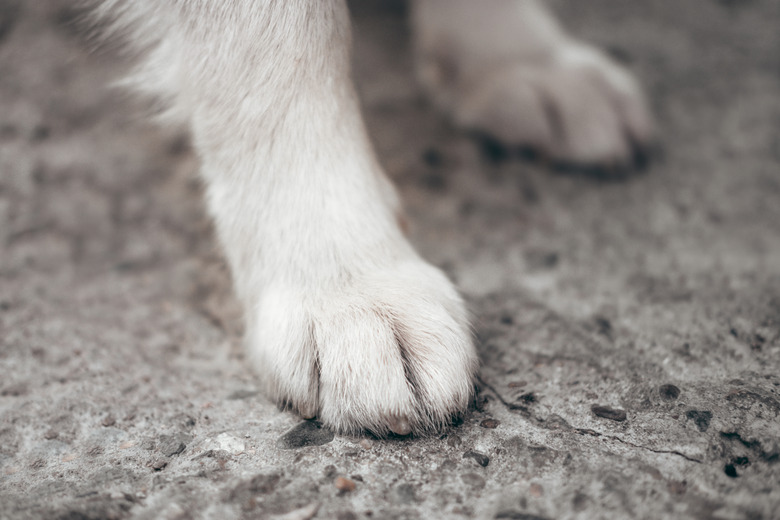How To Soak A Dog's Feet In Epsom Salts
We may receive a commission on purchases made from links.
Cuteness may earn compensation through affiliate links in this article.
Whether you work out, are on your feet at work, or simply enjoy a relaxing bath at the end of a long day, you've likely heard of the benefits of adding Epsom salt to your tub. Known for its ability to soothe tired muscles and reduce swelling or inflamed joints, Epsom salt may also assist your dog's paws with cleaning and disinfection. An Epsom salt bath for dogs may take a bit more patience than a regular bath as your dog's feet need to soak, but it can be done easily and in just a few minutes.
What is Epsom salt?
What is Epsom salt?
Epsom salt, also called magnesium sulfate, is a compound made up of sulfur, oxygen, and magnesium, the latter of which provides the bulk of its health benefits, according to Healthline. The magnesium in Epsom salt is believed to reduce muscle aches and pains, soreness, swelling, and even stress when it's used as a soak, and may help relieve constipation when taken systemically. Epsom salt is also sometimes used to treat minor wounds and skin infections, like fungal overgrowth, and can be used to alleviate symptoms in both humans and their canine counterparts.
Epsom salt for dogs paws
Epsom salt for dogs paws
Drawing up an Epsom salt bath for your dog is quick and easy and only requires two ingredients: Epsom salt and warm water. To use Epsom salt for dogs feet, add warm water to either your bathtub or a container large enough to soak one or more feet, depending on how much attention your dog needs. As the water is running, add Epsom salts following a ratio of about one tablespoon for every four cups of water. Allow the salts to dissolve, then gently rest your dog's paw in the bathwater and allow them to soak for about 10 to 15 minutes if your dog will allow for that long of a session.
Pet Gear Dog Bathing Tub has non-skid footing and double leash restraints to help your dog stay put during his soak. There are also trays for shampoo and other grooming aids and rubberized feet that hold it securely on the surface below. To make a soak or bath more enjoyable, give your pup a massage with the soft rubber tips of a Frisco Rubber Duck Cat & Dog Curry Brush.
A foot soak doesn't need to be as involved as a full-body bath, but Banfield does recommend taking a few precautions for the most pleasant experience, like keeping your dog's nails trimmed, taking care to keep the temp warm and not hot or steaming, and warming towels to dry off your dog's feet after the soak. Finally, be sure to dry them thoroughly with a towel to prevent the possible build-up of fungus, which can lead to an irritating yeast infection in between his toes.
Using a single-paw soaker such as the Top Paw Canine Foot Bath allows you to keep splashing to a minimum. Just insert one paw at a time in an Epsom salt solution in the soaker, swish it around and let it soak for the appropriate amount of time. The device lets you soak just one paw — such as a hurt or inflamed foot — or do all four feet one at a time.
Tips on soaking dogs' paws
Tips on soaking dogs' paws
Banfield reminds pet owners that the sound and rush of water coming out of a faucet can be scary to dogs. If that is the case with your dog, fill up the soaking tub first, then bring them into the tub area. Perform the soak at a time when your pet is calm, and there are few noises and distractions in your home.
Things to keep in mind
Things to keep in mind
When shopping for Epsom salts to use as a foot soak for your dog, be sure to reach for the regular, unscented variety over salts containing fragrance or artificial dyes, which can irritate the skin on some dogs. If your dog has an open wound on her paws, take care to notice whether the Epsom salt may be irritating or uncomfortable, and just opt for a soak in warm water or a thorough wipe-down with a clean towel if so. Because not all dogs enjoy bath time, be sure to time soaks to occur when your dog is least energetic, anxious, or irritable, like after a walk or meal, and not when she is especially energetic or playful.
Always check with your veterinarian before changing your pet's diet, medication, or physical activity routines. This information is not a substitute for a vet's opinion.
